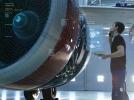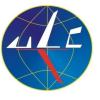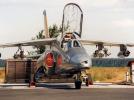Trigana DHC6 at Apalapsili on Feb 5th 2013, runway excursion on landing
A Trigana Air Service de Havilland DHC-6-300 Twin Otter, registration PK-YRF performing a charter cargo flight from Jayapura to Apalapsili (Indonesia) with 3 crew, performed a visual approach to Apalapsili's runway 15. Following a normal downwind and configuration the aircraft touched down on about what would be the center line of the runway and in the designated touch down area, but veered to the left and went off the runway coming to a stop about 500 meters past the runway threshold with the nose and left main gear in a drainage ditch. There were no injuries, the aircraft received substantial damage.
Indonesia's National Transportation Safety Committee (NTSC) released their final report concluding the probable causes of the occurrence rated a serious incident were:
- The PIC has not flown to Apalapsili Aerodrome for more than 2 years.
- The aircraft did not align to the runway bearing since touchdown as result of misalign with the runway on final.
- The PIC action to recover the situation by applying thrust reverser, brake and nose wheel steering were differed to the technique and statement in the AOM.
The NTSC reported the captain (52, ATPL, 6,666 hours total, 5,748 hours on type) was pilot flying, the first officer (30, CPL, 2,876 hours total, 436 hours on type) was pilot monitoring.
The NTSC reported that the crew acquired weather information about Apalapsili Aerodrome from other pilots who had flown from Jayapura to Wamena via Apalapsili and reported Apalapsili weather was clear.
The aircraft performed an uneventful departure and cruise to Apalapsili, the crew descended the aircraft and passed over the aerodrome, the captain decided to land on runway 15 using a normal configuration, the Vref was thus set to 70 KIAS.
The aircraft touched down on runway 15 on or near what would be the center line of the runway but skidded to the left. The captain pushed the right hand pedal, pressed the right hand brakes and engaged right hand reverse in order to recover the aircraft, which however continued to drift left until it came to a stop about 500 meters down the runway with the nose, nose gear and left main gear in a drainage ditch. Both left and right hand doors could not be opened, the crew vacated the aircraft through the cargo door.
The NTSC reported there were no injuries, the aircraft however received substantial damage (but the NTSC rated the occurrence a serious incident).
The NTSC stated the runway consisted of clay and sandy base with a grass surface and was slippery after rain the previous night.
Touchdown marks on the runway suggested that the aircraft touched down on the "center of the runway" (meaning on what would be the center line of the runway if present, not meaning the mid point of the runway), the tracks indicated the aircraft continued along a straight line towards the left from touchdown to stop suggesting the aircraft had never been aligned with the runway. The track of the nose wheel was closer to the right hand gear tracks than to the left suggesting the aircraft was skidding sideways. The aircraft exited the runway about 400 meters down the runway and came to a stop 500 meters down the runway.
The NTSC analysed that during final approach the captain had perceived the aircraft was aligned with the runway whereas the first officer perceived the aircraft was to the left of the runway center line and reminded the captain to align with the runway. The different perceiption remained unresolved however throughout the final approach.
The NTSC analysed that the recovery technique according to AOM was to release brakes and reduce revsere in order to return to the center line of the runway. Reverse thrust would increase the skid inertia, while brakes would reduce the tyres' capability to maintain direction. The use of rudder and differential braking is recommended to recover to the center line of the runway.
The aircraft operating manual said specifically: "If the aircraft weathervanes into the wind and drifted away from centre line, recover by cancelling reverse, release brakes, regain and keep centre line with use of rudder, nose wheel and differential reverse as necessary."
The NTSC thus analysed: "The PIC action to recover the situation by applying thrust reverser, brake and nose wheel steering were differed to the technique and statement in the AOM and worsening the condition."
The damaged aircraft (Photo: NTSC):
Tracks on the runway (Photo: NTSC):
http://avherald.com/h?article=47609299














Komentarze